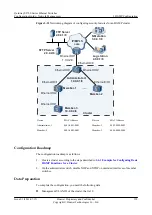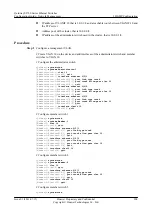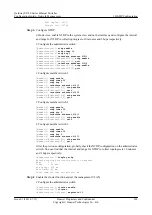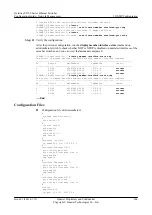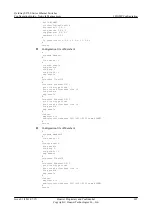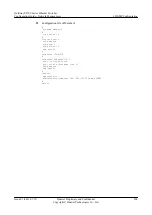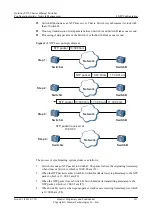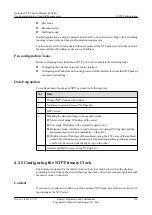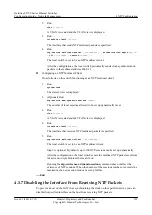
Switch A uses the received information to calculate the following two important values:
l
Delay for the NTP message cycle: Delay = (T4 - T1) - (T3 - T2).
l
Offset of Switch A relative to Switch B: Offset = ((T2 - T1) + (T3 - T4))/2.
According to the delay and the offset, Switch A sets its own clock again to synchronize
with the clock of Switch B.
The preceding example is only a simple description of the NTP operating principle. As
described in RFC 1305, NTP uses a complex algorithm to ensure the precision of clock
synchronization.
The server and client are two relative concepts. The device that provides standard time is
referred to as a time server, and the device that enjoys the time service is referred to as a
client.
4.2 NTP Supported by the S2700
This part describes NTP operating modes supported by the S2700.
The switch supports the following NTP working modes
l
l
l
l
Unicast Server/Client Mode
In this mode, you need to configure only the client. The server needs to be configured with only
one NTP primary clock.
Note that the client can be synchronized to the server but the server cannot be synchronized to
the client.
After the configuration:
1.
The client sends a synchronization request packet to the server, with the mode field being
set to 3. The value 3 indicates the client mode.
2.
Upon receiving the request packet, the server automatically works in the server mode and
sends a response packet with the mode field being set to 4. The value 4 indicates the server
mode.
3.
After receiving the response packet, the client performs clock filtering and selection, and
finally, is synchronized with the optimal server.
Peer Mode
In this mode, you need to configure NTP only on the symmetric active end. The symmetric active
end and symmetric passive end can be synchronized with each other.
Note that the clock with a lower stratum is synchronized to the one with a higher stratum.
After the configurations:
Quidway S2700 Series Ethernet Switches
Configuration Guide - Network Management
4 NTP Configuration
Issue 01 (2011-07-15)
Huawei Proprietary and Confidential
Copyright © Huawei Technologies Co., Ltd.
212


